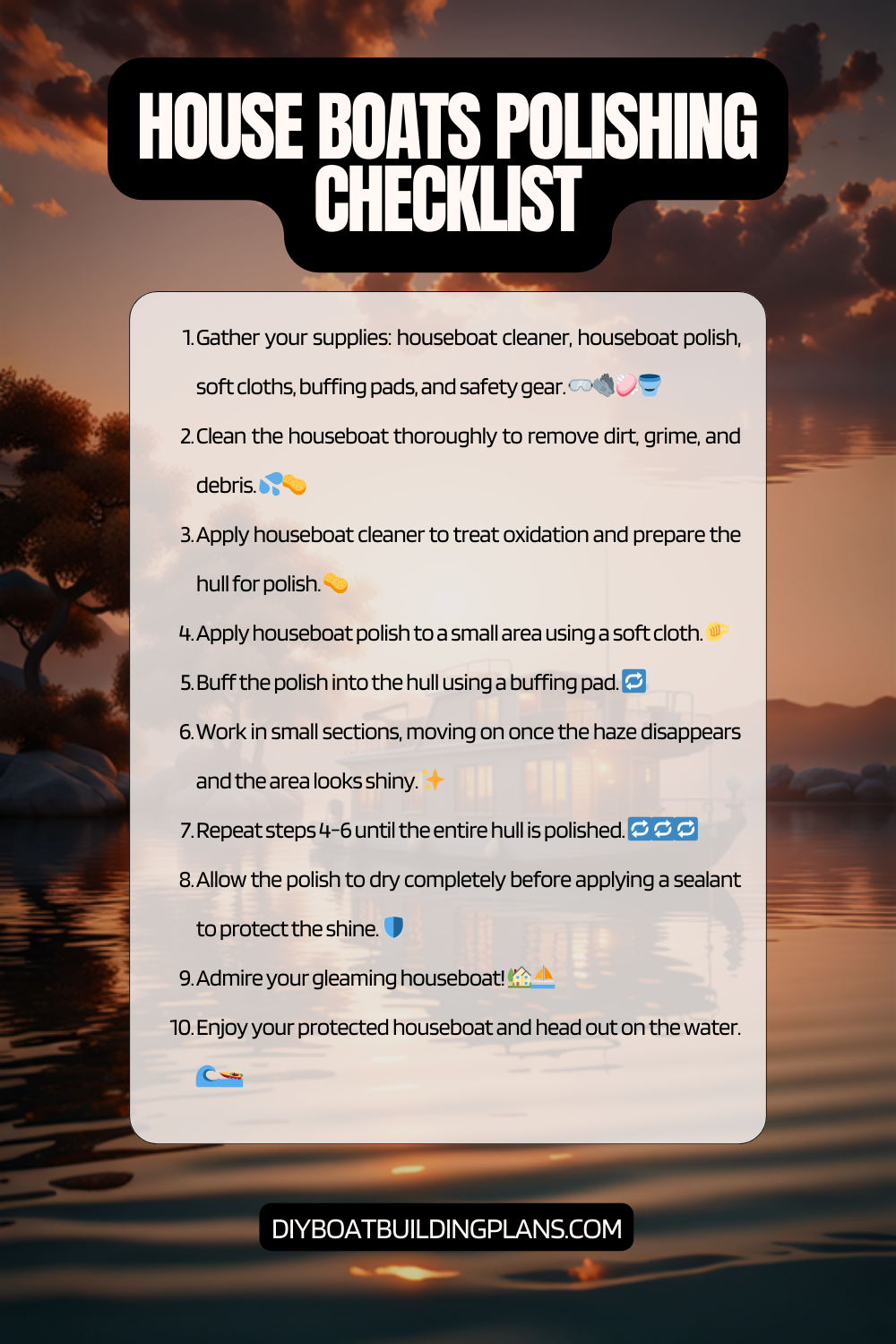Overview of House Boat Polishing Tips
House boat polishing refers to the process of restoring and maintaining the appearance of a house boat by removing imperfections, restoring shine, and protecting the boat’s surface. It involves using specialized products and techniques to enhance the boat’s aesthetic appeal and protect it from the harsh elements of water, sun, and pollution. Maintaining the appearance of a house boat is crucial not only for its visual appeal but also for its longevity and value.
A house boat is a significant investment, and its appearance plays a vital role in its overall value. Regular polishing helps to preserve the boat’s exterior and keep it looking new for years to come. It also helps to protect the boat from damage caused by oxidation, UV rays, saltwater, and other environmental factors. By investing time and effort into house boat polishing, owners can ensure that their vessel remains in top condition and retains its value.
Key Takeaways
- Regular house boat polishing is important to maintain the appearance and value of your boat.
- Choosing the right polishing products and preparing the boat properly are crucial for achieving a polished surface.
- Different materials require different polishing techniques, so it’s important to know what works best for your boat.
- Don’t forget to polish hard-to-reach areas and maintain the polished surface to keep it looking great.
- If you’re not confident in your polishing skills, consider hiring a professional house boat polishing service.

Importance of Regular House Boat Polishing
Regular house boat polishing offers numerous benefits that go beyond just improving the appearance of the vessel. Firstly, it helps to remove surface imperfections such as scratches, swirl marks, and oxidation, which can dull the boat’s shine. Polishing restores the boat’s glossy finish, making it look brand new again.
Furthermore, neglecting house boat polishing can have severe consequences. Over time, exposure to sun, water, and pollutants can cause irreversible damage to the boat’s surface. Oxidation can occur, leading to a chalky appearance that is difficult to remove. Neglected boats may also develop deep scratches or stains that are challenging to repair without professional intervention. Regular polishing acts as a preventive measure against these issues, ensuring that the boat remains in optimal condition.
Choosing the Right Polishing Products
When it comes to house boat polishing, choosing the right products is crucial for achieving desired results. There are various types of polishing products available in the market, each designed for specific boat materials and conditions. Understanding the different types and factors to consider can help boat owners make informed decisions.
Polishing products can be broadly categorized into compounds, polishes, and waxes. Compounds are abrasive products used to remove deep scratches, oxidation, and other imperfections. Polishes are less abrasive and are used to refine the surface after compounding. Waxes provide a protective layer that enhances shine and repels water and pollutants.
When choosing polishing products, factors such as boat material, level of oxidation or damage, and personal preferences should be considered. Different materials may require specific products or techniques to achieve the best results. It is essential to read product labels, seek professional advice if needed, and conduct thorough research before making a purchase.
Preparing the Boat for Polishing
| Task | Time Required | Materials Needed | Tools Required |
|---|---|---|---|
| Cleaning the Boat | 2 hours | Boat soap, water, scrub brush, sponge | Bucket, hose |
| Sanding the Boat | 4 hours | Sandpaper (various grits), sanding block, masking tape | Orbital sander, dust mask, safety glasses |
| Applying Compound | 3 hours | Compound, applicator pad, microfiber towel | Buffer, extension cord |
| Polishing the Boat | 2 hours | Polish, applicator pad, microfiber towel | Buffer, extension cord |
Before diving into the polishing process, it is crucial to prepare the boat properly. This involves cleaning the boat thoroughly to remove dirt, grime, and any existing wax or polish residue. A clean surface ensures that the polishing products can work effectively and achieve optimal results.
Start by washing the boat with a mild detergent or boat-specific cleaner. Use a soft brush or sponge to scrub away dirt and grime from all surfaces, including hard-to-reach areas. Rinse the boat thoroughly with clean water to remove any soap residue.
Next, it is essential to remove any old wax or polish that may be present on the boat’s surface. This can be done using a specialized wax remover or by using a mixture of vinegar and water. Apply the wax remover or vinegar solution onto a clean cloth or sponge and gently rub it onto the surface in circular motions. This will help dissolve and lift off any old wax or polish residue.
By thoroughly cleaning and removing old wax or polish, the boat is now ready for the polishing process.
Step-by-Step Guide to House Boat Polishing
To achieve professional-looking results, following a step-by-step guide is essential. Here is a basic outline of the house boat polishing process:
1. Applying polish: Start by applying a small amount of polish onto a clean, soft cloth or applicator pad. Work in small sections, applying the polish in circular motions. Ensure even coverage and avoid applying too much pressure.
2. Buffing the surface: Once the polish has been applied, use a buffing pad or machine to buff the surface. Move the pad or machine in overlapping motions, applying light to moderate pressure. This helps to evenly distribute the polish and remove any imperfections.
3. Removing excess polish: After buffing, use a clean microfiber cloth to remove any excess polish from the surface. This step ensures a smooth and streak-free finish.
Repeat these steps for each section of the boat until the entire surface has been polished.
Polishing Techniques for Different Boat Materials
Different boat materials require specific polishing techniques to achieve optimal results. Here are some techniques for common boat materials:
1. Fiberglass: Fiberglass boats are popular due to their durability and versatility. To polish fiberglass, start by cleaning the surface thoroughly and removing any oxidation or stains using a fiberglass cleaner or compound. Apply a fiberglass-specific polish using a soft cloth or applicator pad, working in small sections. Buff the surface using a buffing pad or machine, and remove excess polish with a clean microfiber cloth.
2. Aluminum: Aluminum boats are lightweight and resistant to corrosion, making them ideal for various water activities. To polish aluminum, start by cleaning the surface with an aluminum cleaner or mild detergent. Use an aluminum-specific polish and apply it using a soft cloth or applicator pad. Buff the surface gently using a buffing pad or machine, and remove excess polish with a clean microfiber cloth.
3. Wood: Wooden boats require special care to maintain their natural beauty. Start by cleaning the wood with a mild detergent or wood cleaner. If there are any stains or discoloration, use a wood-specific cleaner or compound to remove them. Apply a wood polish or wax using a soft cloth or applicator pad, working in the direction of the wood grain. Buff the surface gently using a buffing pad or machine, and remove excess polish with a clean microfiber cloth.
Tips for Polishing Hard-to-Reach Areas
Polishing hard-to-reach areas of a house boat can be challenging but not impossible. Here are some tips to make the process easier:
1. Using specialized tools: Invest in specialized tools such as small buffing pads, foam brushes, or detailing brushes to reach tight corners, crevices, and intricate areas. These tools allow for better control and precision when polishing hard-to-reach spots.
2. Being patient and careful: Take your time when polishing hard-to-reach areas. Apply polish in small amounts and work in gentle, circular motions. Avoid applying excessive pressure, as it can lead to damage or uneven results. Patience and attention to detail are key to achieving a polished finish in difficult areas.
Maintaining the Polished Surface
Once the house boat has been polished, it is essential to maintain the polished surface to prolong its shine and protection. Regular cleaning and applying protective coatings can help preserve the boat’s appearance.
Regularly clean the boat using a mild detergent or boat-specific cleaner to remove dirt, saltwater residue, and other pollutants. Avoid using abrasive cleaners or brushes that can scratch the surface.
Applying protective coatings such as wax or sealants can provide an additional layer of protection against UV rays, oxidation, and water damage. Follow the manufacturer’s instructions when applying these coatings and reapply them as recommended.
Common Mistakes to Avoid When Polishing a House Boat
While house boat polishing can be a rewarding process, there are some common mistakes that should be avoided:
1. Using the wrong products: Using the wrong polishing products for your boat’s material can lead to unsatisfactory results or even damage. Always choose products specifically designed for your boat’s material and follow the manufacturer’s instructions.
2. Applying too much pressure: Applying excessive pressure when polishing can cause swirl marks, scratches, or even remove the boat’s gel coat. Use a light to moderate pressure and let the polishing products do the work.
3. Skipping steps: Skipping important steps such as cleaning or removing old wax can compromise the final result. Take the time to properly prepare the boat before polishing and follow each step of the process for optimal results.
Download over 500 Boat Plans. Click on the link below.
-->Click Here<--
Hiring a Professional House Boat Polishing Service
While DIY house boat polishing can be a rewarding task, some boat owners may prefer to hire a professional service. Hiring professionals offers several benefits, including expertise, specialized equipment, and time-saving.
Professional polishers have extensive knowledge and experience in working with different boat materials and conditions. They can provide expert advice on the best products and techniques for achieving desired results. Additionally, professionals often have access to specialized equipment that can deliver superior polishing outcomes.
When choosing a professional house boat polishing service, consider factors such as reputation, experience, customer reviews, and pricing. Request quotes from multiple providers and compare their services before making a decision.
House Boat Polishing Checklist

Conclusion – House Boat Polishing Tips
In conclusion, house boat polishing is an essential aspect of maintaining the appearance and value of a house boat. Regular polishing not only enhances the boat’s aesthetic appeal but also protects it from environmental damage.
Choosing the right polishing products, preparing the boat properly, and following a step-by-step guide are crucial for achieving professional results. Different boat materials require specific techniques, so it is essential to understand the requirements of your boat’s material.
Maintaining the polished surface through regular cleaning and applying protective coatings is vital for long-term preservation. Avoiding common mistakes and considering professional services when needed can further enhance the polishing process.
By investing time and effort into house boat polishing, owners can ensure that their vessel remains in top condition, providing years of enjoyment on the water. So, take pride in your house boat and keep it shining!
FAQs – House Boat Polishing Tips
What is house boat polishing?
House boat polishing is the process of cleaning and restoring the exterior of a house boat to its original shine and luster.
Why is house boat polishing important?
House boat polishing is important to maintain the appearance and value of the boat. It also helps to protect the boat from damage caused by exposure to the elements.
What are some tips for house boat polishing?
Some tips for house boat polishing include using a high-quality marine polish, using a buffer or polisher, working in small sections, and applying the polish in a circular motion.
What materials are needed for house boat polishing?
Materials needed for house boat polishing include a high-quality marine polish, a buffer or polisher, microfiber towels, and a hose or pressure washer.
How often should house boat polishing be done?
House boat polishing should be done at least once a year, but may need to be done more frequently depending on the condition of the boat and the amount of use it receives.
Can house boat polishing be done by a novice?
House boat polishing can be done by a novice, but it is recommended to seek the advice of a professional or experienced boater before attempting the process. It is also important to follow all safety precautions and use the proper equipment.



